Are reset controllers necessary for modern microcontrollers, such as the LPC2138 or 9S12XD256? Most ARM processors I have seen have their own brown-out detectors and reset properly, and I don't see reset controllers used with them. However, I've needed to use them on a 9S12-series part in the past, so I'm debating whether or not to use them on a 9S12X based descendant.
3 Answers
You only mention brown-out as a reset condition. However, in some systems, there could be multiple reasons for wanting to reset the processor. In which case, having a separate chip to monitor all those reasons and either reset the processor or provide it with some type of notification could be of benefit.
For an extreme case, take a look at the Lattice ispPAC-POWER607. It is capable of monitoring six power supplies, digital I/O for manual reset, and external watchdog circuitry. It also has it's own internal timers, the power supply monitors are completely programmable, it has an embedded PLD for logic code, and it has FET drivers to control the power supplies.

Like I said, that is an extreme example. Especially if all you need is brown-out detection. But if your system has a more complicated reset scheme, then having an external programmable controller can be very useful.
And there are, of course, chips to suit any need in between the three pin single voltage monitor and the 32-pin fully programmable system management chip.
- 8,411
- 2
- 26
- 44
Many microcontrollers won't need rest controllers anymore, as they have internal reset and brwon-out detection, like you say. There are still exceptions, though, like some MSP430 controllers I've worked with.
One reason to work with external reset controllers may be power usage. A brown-out detector may consume several tens of µA, which may not seem to be the end of the world, unless you want to run the microcontroller on an average of 5 µA. IIRC AVR's BODs need something like 35 µA. They suggest to switch it off to save power, but that's a Bad Idea™, unless you have an alternative.
I've used MAX809 reset controllers with MSP430 microcontrollers, which together with a voltage regulator needed less than 7 µA.
You do not want the Maxim devices, they consume up to 35 µA. Go for OnSemi, their MAX809 consumes less than 1.2 µA.
- 145,145
- 21
- 455
- 667
-
2Another thing to consider is that while any type of power-on/brown-out detector circuit has a possibility of going metastable if the power supply goes up and down in just the "right" way (or "wrong" way, depending upon your point of view) way, programmable options to enable or disable the brown-out circuit may add more failure modes (e.g. the brown-out is supposed to be enabled, but the circuit gets erroneously latched into thinking it's supposed to be disabled). Having a detector that's hard-wired as "enabled" can avoid such dangers. – supercat Aug 20 '12 at 19:31
-
1@downvoter - You just downvote without saying a word. How can I improve/correct my answer if you don't say what's wrong with it? – stevenvh Aug 21 '12 at 06:11
External reset controllers are an absolute requirement in high-integrity applications, e.g. rail and aerospace. An "independant monitor" is seperate from code and does not require clocking, meaning the boards MTBF increases as a result - just whats needed in these kind of environments. Also they are used in multi-CPU designs or where there are combinations of CPUs, FPGAs, CPLDs etc to give a "global reset" to all devices, you might want to avoid the situation of 2 devices having slightly different brownout levels hence being in different operating states
- 928
- 4
- 5